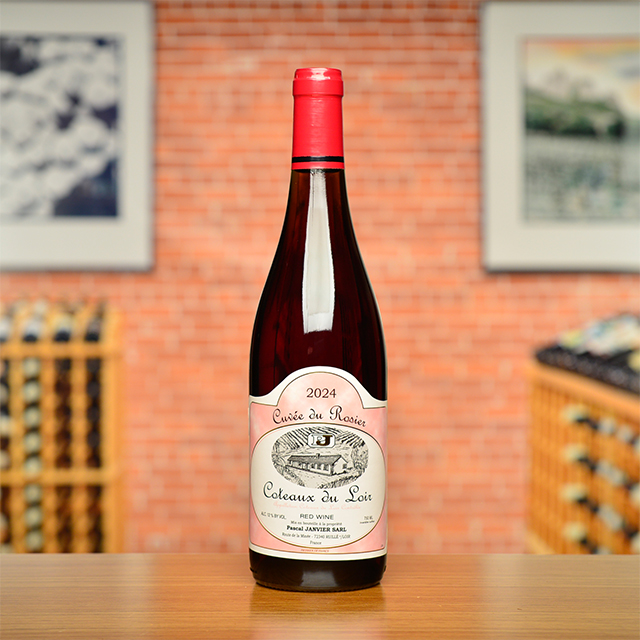Notify me
2015 Sancerre “Clos des Bouffants”
Domaine Roger Neveu
| Wine Type: | white |
| Vintage: | 2015 |
| Bottle Size: | 750mL |
| Blend: | Sauvignon Blanc |
| Appellation: | Sancerre |
| Country: | France |
| Region: | Loire |
| Producer: | Domaine Roger Neveu |
| Winemaker: | Éric & Jean-Philippe Neveu |
| Vineyard: | 20 years average, 18 ha |
| Soil: | Limestone |
| Aging: | Wine aged for 3 months before first racking, aged for 8 to 12 months in total |
| Farming: | Lutte Raisonnée |
| Alcohol: | 12.5% |
More from this Producer or Region

2024 Sancerre Rosé
France | Loire
Sancerre Rosé is made from Pinot Noir grown in Kimmeridgian limestone soil, and the Neveu family’s interpretation is fine, floral, crisp, and bone-dry.

2022 Quincy “Château de Quincy”
France | Loire
Textured, lush, full of aromatic gooseberry and passionfruit—all supported by spiny minerality.

Vouvray Brut
France | Loire
Made from Chenin Blanc in the Champagne method, this cuvée is the quintessential apéritif sparkling wine, with notes of apple and pear and a fine bead.

2020 Saumur Champigny “Outre Terre”
France | Loire
Outre Terre is a tiny production of Cabernet Franc fermented in amphora and aged in barrel.

2024 Muscadet Sèvre et Maine Sur Lie
France | Loire
Classic Muscadet aromas endure, but there’s a complexity here that’s uncommon for an appellation known for its simple oyster wines.

2019 Vouvray “Bois Guyon”
France | Loire
Unique in its combination of honeyed richness and flinty verve. Hard to resist on its own, but you might also try serving it with salty-sweet yakitori or buffalo chicken wings.

2022 Chinon “Cuvée Terroir”
France | Loire
The perfect combination of tart red fruit, herbaceousness, and graphite earthiness.

2021 Bourgueil “La Dilettante”
France | Loire
A delicate, aromatic red in the “drink now!” vein.

2023 Sancerre Blanc “Pierre François Xavier Vieilles Vignes”
France | Loire
The oak adds a grain and level of class and backbone that raises this cuvée a step above the domaine’s classic Sancerre bottling.

2024 Coteaux du Loir Rouge “Cuvée du Rosier”
France | Loire
This red is 100% Pineau d’Aunis, an indigenous red grape we hold dear because of its mystifying aromatics and bright, juicy texture.
 /
/
About The Producer
Domaine Roger Neveu
About The Region
Loire

The defining feature of the Loire Valley, not surprisingly, is the Loire River. As the longest river in France, spanning more than 600 miles, this river connects seemingly disparate wine regions. Why else would Sancerre, with its Kimmeridgian limestone terroir be connected to Muscadet, an appellation that is 250 miles away?
Secondary in relevance to the historical, climatic, environmental, and cultural importance of the river are the wines and châteaux of the Jardin de la France. The kings and nobility of France built many hundreds of châteaux in the Loire but wine preceded the arrival of the noblesse and has since out-lived them as well.
Diversity abounds in the Loire. The aforementioned Kimmeridgian limestone of Sancerre is also found in Chablis. Chinon, Bourgueil, and Saumur boast the presence of tuffeau, a type of limestone unique to the Loire that has a yellowish tinge and a chalky texture. Savennières has schist, while Muscadet has volcanic, granite, and serpentinite based soils. In addition to geologic diversity, many, grape varieties are grown there too: Cabernet Franc, Chenin Blanc, Sauvignon Blanc, and Melon de Bourgogne are most prevalent, but (to name a few) Pinot Gris, Grolleau, Pinot Noir, Pineau d’Aunis, and Folle Blanche are also planted. These myriad of viticultural influences leads to the high quality production of every type of wine: red, white, rosé, sparkling, and dessert.
Like the Rhône and Provence, some of Kermit’s first imports came from the Loire, most notably the wines of Charles Joguet and Château d’Epiré—two producers who are featured in Kermit’s book Adventures on the Wine Route and with whom we still work today.
More from Loire or France
2021 Vin de France Rosé Grolleau/Cabernet Franc “Les Arceaux”
Grange Saint-Sauveur France | Loire
2022 Jasnières “Dyane”
Christine de Mianville France | Loire
2024 Chinon Rosé
Bernard Baudry France | Loire
2021 Vin de France Blanche
Domaine Michel Brégeon France | Loire
2024 Muscadet “Le Clos de la Butte”
Eric Chevalier France | Loire
2024 Saumur Blanc “L’Insolite”
Thierry Germain France | Loire
2023 Chinon “Les Petites Roches”
Charles Joguet France | Loire
2024 Cheverny
Domaine du Salvard France | Loire
2022 Sancerre Rouge “Champs d’Alligny”
Daniel Chotard France | Loire
2024 Reuilly “Les Pierres Plates”
Domaine de Reuilly France | Loire
2023 Quincy “Vieilles Vignes”
Domaine Trotereau France | Loire
2022 Muscadet Sèvre et Maine “Réserve”
Domaine Michel Brégeon France | Loire
2021 Vin de France Rosé Grolleau/Cabernet Franc “Les Arceaux”
Grange Saint-Sauveur France | Loire
2022 Jasnières “Dyane”
Christine de Mianville France | Loire
2024 Chinon Rosé
Bernard Baudry France | Loire
2021 Vin de France Blanche
Domaine Michel Brégeon France | Loire
2024 Muscadet “Le Clos de la Butte”
Eric Chevalier France | Loire
2024 Saumur Blanc “L’Insolite”
Thierry Germain France | Loire
2023 Chinon “Les Petites Roches”
Charles Joguet France | Loire
2024 Cheverny
Domaine du Salvard France | Loire
2022 Sancerre Rouge “Champs d’Alligny”
Daniel Chotard France | Loire
2024 Reuilly “Les Pierres Plates”
Domaine de Reuilly France | Loire
2023 Quincy “Vieilles Vignes”
Domaine Trotereau France | Loire
2022 Muscadet Sèvre et Maine “Réserve”
Domaine Michel Brégeon France | Loire
Vintage Chart Mentality

Vintage Chart Mentality
Trust the great winemakers, trust the great vineyards. Your wine merchant might even be trustworthy. In the long run, that vintage strip may be the least important guide to quality on your bottle of wine.—Kermit Lynch














